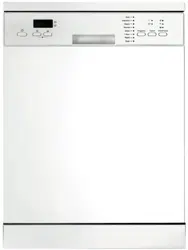Documents: Go to download!
User Manual
- User Manual - (English)
- Smeg DWIFABNE-1 Under Bench Dishwasher Specifications Sheet - (English)
User manual Dishwasher
Parts and Features

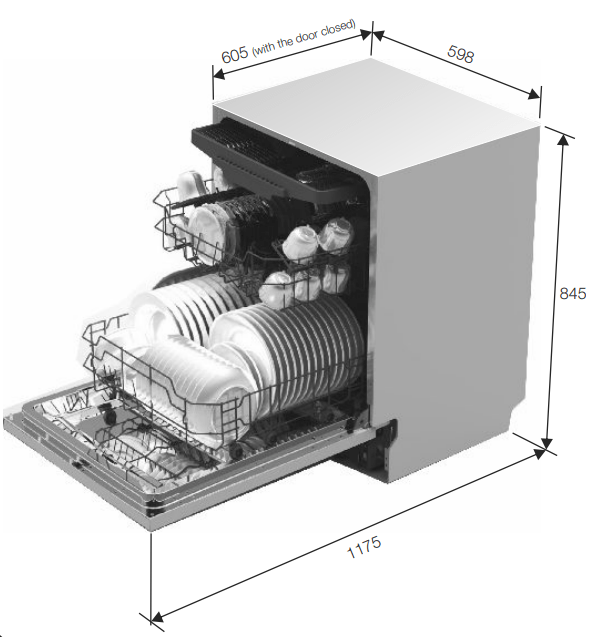
Dimensions:
- Height: 845mm
- Width: 598mm
- Depth: 605mm (with door closed)
- Voltage connected Load: see rating label
- Water pressure: 0.04-1.0MPa
- Power supply: see rating label
- Capacity: 14 place settings
Using Your Dishwasher
Quick start guide
For detailed operating method read the corresponding content on the instruction manual.
1. Switch on the appliance: Press the On/Off button to switch on the appliance, Open the door.
2. Fill the detergent dispenser
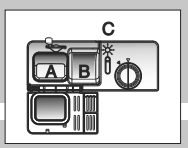
- Compartment A: With each wash cycle.
- Compartment B: For programmes with pre-wash only. (Follow the User Manual!)
3. Check the rinse aid level: Mechanical indicator C. Electric indicator on control panel (if provided).
4. Load the baskets: Scrape off any large amount of leftover food. Soften remnants of burnt food in pans, then load the baskets. Refer to the dishwasher loading instructions.
5. Select a programme: Close the door,press the Programme Button until the selected programme lights up. ( See the section entitled¡Operation instruction¡)
6. Running the dishwasher: T urn on the water tap and press the Start/Pause Button. The machine will start working after about 10 seconds.
- Changing the programme:
- A running cycle can only be modified if it has been running for a short time. Otherwise the detergent may have already been released and the water already drained. If this is the case, the detergent dispenser must be refilled.
- Press the Start/Pause button, press the program button for more than three seconds,the machine will be in standby state, then you can change the program to the desired cycle setting
- Add forgotten dishes in the dishwasher.
- .Press the Start/Pause Button to stop the washing.
- Open the door a little .
- After the spray arms stop working, you can open the door completely.
- Add forgotten dishes.
- Close the door.
- Press the Start/Pause Button, the dishwasher will run after 10 seconds.
- If the appliance is switched off during a wash cycle. If the appliance is switched off during a wash cycle, when switched on again, please re-select the washing cycle and operate the dishwasher according to the original Power-on state.
7. Switch off the appliance: When the working cycle has finished, the buzzer of the dishwasher will sound 8 times, then stop. Turn off the appliance using the On/Off Button.
8. Turn off the water tap, unload the baskets: Warning: wait a few minutes (about 15 minutes) before unloading the dishwasher to avoid handling the dishes and utensils while they are still hot and more susceptible to break. They will also dry better.Unload the appliance, starting from the lower basket.
Before Starting the Dishwasher
The following things should be checked before starting the dishwasher:
- That the dishwasher is level and fixed properly.
- That the inlet valve is open .
- There is no leakage at the connections of the conducts.
- The wires are tightly connected.
- The power is switched on.
- The inlet and drain hoses are not knotted or kinked.
- All packing & print materials should be taken out of the dishwasher.
PRIOR TO USING FOR THE FIRST TIME
Before using your dishwasher for the first time:
Fill the Rinse Aid Dispenser
- The rinse aid is released during the final rinse to prevent water from forming droplets on your dishes, which can leave spots and streaks. It also improves drying by allowing water to roll off the dishes. Your dishwasher is designed to use liquid rinse aids. The rinse aid dispenser is located inside the door next to the detergent dispenser. To fill the dispenser, open the cap and pour the rinse aid into the dispenser until the level indicator turns completely black. The volume of the rinse aid container is about 110ml.
- Function of the Rinse Aid: Rinse aid is automatically added during the last rinse, ensuring thorough rinsing, and spot and streak free drying.
- WARNING! Only use branded rinse aid for dishwashers. Never fill the rinse aid dispenser with any other substances (e.g. Dishwasher cleaning agent, liquid detergent). This would damage the appliance.
- When to refill the Rinse Aid Dispenser: If there is no rinse-aid warning light in the control panel, you can judge the amount of rinse-aid by the colour of the optical level indicator "C" located next to the cap. When the rinse-aid container is full, the whole indicator will be dark. As the rinse-aid diminishes, the size of the dark dot decreases. You should never let the rinse aid get below 1/4 full.
- As the rinse aid diminishes, the size of the black dot on the rinse aid level indicator changes, as illustrated below.
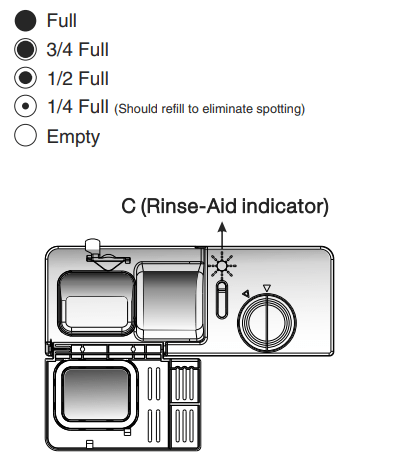
How to fill the Rinse Aid Dispenser
- To open the dispenser, turn the cap to the "open" (left) arrow and lift it out.
- Pour the rinse aid into the dispenser, being careful not to overfill.
- Replace the cap by inserting it aligned with "open" arrow and turning it to the closed (right) arrow.
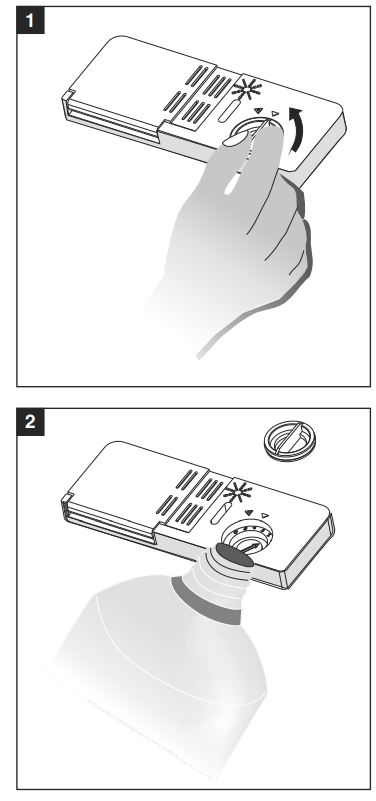

Be careful not to overfill the dispenser, because this could cause over sudsing. Wipe away any spills with a damp cloth. Don't forget to replace the cap before you close dishwasher door.
ATTENTION! Clean up any rinse aid spilt during filling with an absorbent cloth to avoid excess foaming during the next wash.
Adjusting the Rinse Aid Dispenser
- The rinse aid dispenser has six or four settings. Always start with the dispenser set on "4". If spots and poor drying are a problem, increase the amount of rinse aid dispensed by removing the dispenser lid and rotating the dial to "5". If the dishes are still not drying properly or show spots, adjust the dial to the next higher level until your dishes are spot free. The recommended setting is "4". (Factory value is "4".)
- NOTE:Increase the dose if there are drops of water or lime spots on the dishes after washing. Reduce it if there are sticky whitish stains on your dishes or a bluish film on glassware or knife blades.
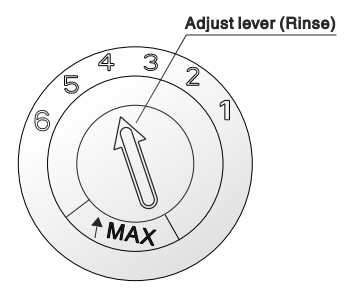
Detergents
- Detergents have chemical ingredients that are necessary to remove dirt, crush dirt and transport it out of the dishwasher. Most of the commercial quality detergents are suitable for this purpose.
- There are 3 sorts of detergents:
- With phosphate and with chlorine
- With phosphate and without chlorine
- Without phosphate and without chlorine
- Normally new pulverised detergent is without phosphate. Thus the water softener function of phosphate is not given. In this case we recommend to fill salt in the salt container even when the hardness of water is only 6 °dH. If detergents without phosphate are used in the case of hard water often white spots appear on dishes and glasses. In this case please add more detergent to reach better results. Detergents without chlorine do only bleach a little. Strong and coloured spots will not be removed completely. In this case please choose a program with a higher temperature.
Concentrated Detergent:
- Based on their chemical composition, detergents can be split in two basic types:
- Conventional, alkaline detergents with caustic components
- Low alkaline concentrated detergents with natural enzymes
- The use of “normal” washing programs in combination with concentrated detergents reduces pollution and is good for your dishes;
- These wash programs are specifically matched to the dirt-dissolving properties of the enzymes of the concentrated detergent. For this reason “normal” wash programs in which concentrated detergents are used can achieve the same results that can otherwise only be achieved using “intensive” programs.
Detergent Tablets
- Detergent tablets of different brands dissolve at different speeds. For this reason some detergent tablets cannot dissolve and develop their full cleaning power during short programs. Therefore please use long programs when using detergent tablets, to ensure the complete removal of detergent residuals.
Detergent Dispenser
- The dispenser must be refilled before the start of each wash cycle following the instructions provided in the wash cycle table. Your dishwasher uses less detergent and rinse aid than Conventional dishwasher. Generally, only one tablespoon of detergent is needed for a normal wash load. More heavily soiled items need more detergent. Always add the detergent just before starting the dishwasher, otherwise it could get damp and will not dissolve properly
Adding detergent to Dishwasher
- If the lid is closed: press release button. The lid will spring open.
- Always add the detergent just before starting each wash cycle.
- Only use branded detergent aid for dishwasher.
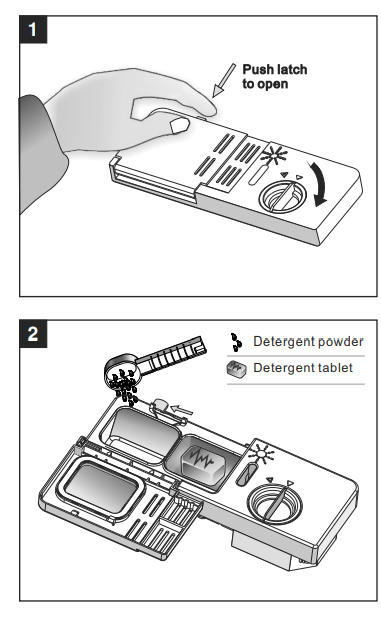
WARNING! Dishwasher detergent is poisonous! Take care to keep it out of reach of children.
Proper Use of Detergent
- Only use detergent specifically made for the use in dishwashers. Keep your detergent fresh and dry.
- Don't put powdered detergent into the dispenser until you're ready to wash dishes.
Fill the detergent dispenser with detergent. The marking indicates the dosing levels, as shown below
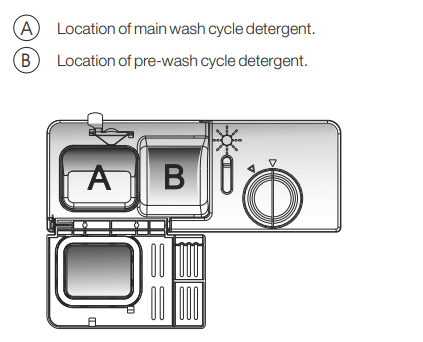
- Please observe the manufacturers dosing and storage recommendations as stated on the detergent packaging.
- Close the lid and press until it locks in place.
- If the dishes are heavily soiled, place an additional detergent dose in the pre-wash detergent chamber. This detergent will take effect during the pre-wash phase.
- NOTE: See information about the amount of detergent for the single programs on page 19. Please be aware, that according to the level soiling and the specific hardness of water differences are possible.
- Please observe the manufacturer's recommendations on the detergent packaging.
LOADING THE DISHWASHER BASKET
Recommendation
- Consider buying utensils which are identified as dishwasher-proof.
- Use a mild detergent that is described as 'kind to dishes'. If necessary, seek further information from the detergent manufacturers.
- For particular items, select a program with as low a temperature as possible.
- To prevent damage, do not take glass and cutlery out of the dishwasher immediately after the programme has ended.
Suitability of use in the dishwasher
NOT SUITABLE FOR USE
- Cutlery with wooden, horn china or mother-ofpearl handles
- Plastic items that are not heat resistant
- Older cutlery with glued parts that are not temperature resistant
- Bonded cutlery items or dishes
- Pewter or cooper items
- Crystal glass
- Steel items subject to rusting
- Wooden platters
- Items made from synthetic fibres
LIMITED SUITABILITY:
- Some types of glasses can become dull after a large number of washes
- Silver and aluminum parts have a tendency to discolour during washing
- Glazed patterns may fade if machine washed frequently
Attention before or after Loading the Dishwasher Baskets.
- For best performance of the dishwasher, follow these loading guidelines. Features and appearance of baskets and cutlery baskets may vary from your model.
- Scrape off any large food particles. Soften remnants of burnt food in pans.
It is not necessary to rinse the dishes under running water. Place objects in the dishwasher in following way:
- Items such as cups, glasses, pots/pans, etc. are faced downwards.
- Curved items, or ones with recesses, should be loaded aslant so that water can run off.
- All utensils are stacked securely and can not tip over.
- All utensils are placed in the way that the spray arms can rotate freely during washing.
NOTE: Very small items should not be washed in the dishwasher as they could easily fall out of the baskets.
- Load hollow items such as cups, glasses, pans etc. With the opening facing downwards so that water cannot collect in the container or a deep base.
- Dishes and items of cutlery must not lie inside one another, or cover each other.
- To avoid damage to glasses, they must not touch.
- Load large items which are most difficult to clean into the lower basket.
- The upper basket is designed to hold more delicate and lighter dishware such as glasses, coffee and tea cups
- Long bladed knives stored in an upright position are a potential hazard!
- Long and/or sharp items of cutlery such as carving knives must be positioned horizontally in the upper basket.
- Please do not overload your dishwasher. This is important for good results and for reasonable consumption of energy.
Removing the Dishes: To prevent water dripping from the upper basket into the lower basket, we recommend that you empty the lower basket first and then the upper basket.
Loading the Upper Basket
- The upper basket is designed to hold more delicate and lighter dishware such as glasses, coffee and tea cup and saucers, as well as plates, small bowls and shallow pans (as long as they are not too dirty).
- Position the dishes and cookware so that they do not get moved by the spray of water.
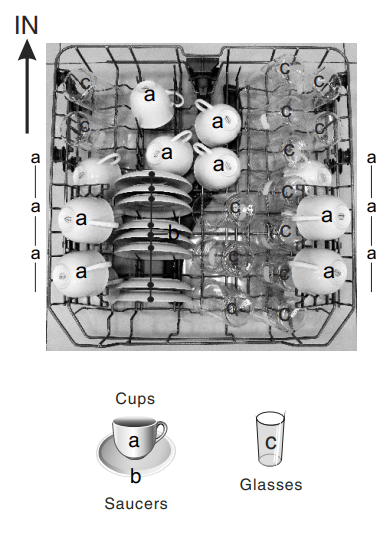
Please be reminded that:
- Pots, serving bowls, etc, must always be placed top down.
- Deep pots should be slanted to allow water to flow out.
- The Bottom Basket features folding spikes so that larger or more pots and pans can be loaded.
Adjusting the Upper Basket
- The height of the upper basket can be adjusted in order to create more space for large utensils both for the upper/lower basket. The height of the upper basket can be adjusted by lifting the handle on either side of the basket, see pictures below:
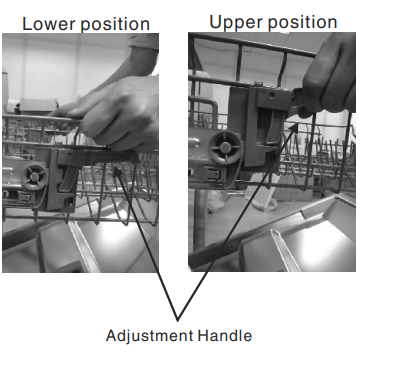
Folding back the cup shelves
- For reduced loads, the additional cup shelves can be folded down if not required as shown below.

Loading the Lower Basket
- We suggest that you place large items and the most difficult to clean items are to be placed into the lower basket: such as pots, pans, lids, serving dishes and bowls, as shown in the figure below.
- It is preferable to place serving dishes and lids on the side of the racks in order to avoid blocking the rotation of the top spray arm.

Folding spikes of Lower Basket
- For better stacking of pots and pans, the spikes can be folded down as show in the picture below.
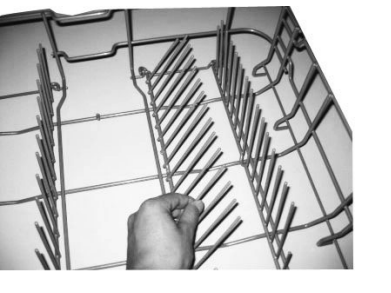
Cutlery Basket
- Cutlery should be placed in the cutlery rack separately from each other in the appropriate positions shown below. Make sure the utensils do not nest together, this may cause bad performance.
- For a top quality clean, place the silverware in the basket making sure that:
- They do not nest together.
- Silverware is placed with the male face up.
- Long utensils in the middle.

Damage to glassware and other dishes
Possible Causes
- Type of glass or manufacturing process. Chemical composition of detergent.
- Water temperature and duration of dishwasher program.
Suggested remedy:
- Use glassware or porcelain dishes that have been marked dishwasher-proof by the manufacturer Ÿ Use a mild detergent that is described as kind of dishes If necessary, seek further information from detergent manufacturers.
- Select a program with as low a temperature.
- To prevent damage, take glass and cutlery out of the dishwasher as soon as possible after the program has ended. as possible after the program has ended.
CONTROL PANEL

- Power button: To turn on/off the power supply.
- Display screen: to show the remaining time and the state(running state, delay time,error codes etc)
- Rinse Aid indicator:
 Indicates when the dispenser needs to be refilled.
Indicates when the dispenser needs to be refilled. - Delay time, Remain time ,or error codes indicator:

- Rinse Aid indicator:
- Alt function indicator:

- Program indicators:

- Other indicators:
- Water faucet indicator

- Express indicator:
 This function can reduce the running time, water and energy consumption are slight increased. (This function can only be used with programmes Intensive, Heavy, Normal and Glass ).
This function can reduce the running time, water and energy consumption are slight increased. (This function can only be used with programmes Intensive, Heavy, Normal and Glass ). - Rinse Aid indicator:
 Indicates when the dispenser needs to be refilled.
Indicates when the dispenser needs to be refilled. - Child lock indicator:

- Extra drying: An increased temperature during the final rinse to improve drying. Slight increase in energy consumption.
 (This function can only be used with programmes Intensive, Heavy, Normal, Glass and 1 Hour).
(This function can only be used with programmes Intensive, Heavy, Normal, Glass and 1 Hour).
- Water faucet indicator
- Delay Button: Press to delay the wash
- Alt Button: Dual zone wash function, press the button to select either upper basket or lower basket loaded, and the response indicator
- Program Button: Press to select the appropriate program.
- Express and Extra Drying function Button: Press to select the express and extra drying function.
- Start /Pause button: To start the selected washing program or pause the washing program when the machine is working.
Attention: Child lock function: press two buttons( + Alt) simultaneously to lock the program.
+ Alt) simultaneously to lock the program.
TURNING ON THE APPLIANCE
Starting a wash cycle:
- Draw out the lower and upper basket, load the dishes and push them back. It is recommended to load the lower basket first, then the upper one (see the section entitled “Loading the Dishwasher”).
- Pour in the detergent (see Page 14).
- Insert the plug into the socket. The power supply is 220-240 VAC /50 HZ, the specification of the socket is 10A 250VAC. Make sure that the water supply is turned on to full pressure.
- Close the door, press the ON/OFF button to switch on the machine.
- Press the program button to select your desired program, when the program is selected, the response icon will light, then press the Start/Pause button, the dishwasher begins to start.
NOTE: When you press the Start/Pause button to pause during washing, the running indicator will stop blinking and the dishwasher will sound every minute unless you press the Start/Pause button to start.
CHANGE THE PROGRAM
Premise:
- A cycle that is underway can only be modified if it has only been running for a short time. Otherwise, the detergent may have already been released, and the appliance may have already drained the wash water. If this is the case, the detergent dispenser must be refilled (see the section entitled "Adding Detergent").
- Press the Start/Pause button, the machine will be in standby mode, then press the program button more than 3 seconds then you can change the program to the desired cycle setting (see the section entitled " Starting a wash cycle. . .").
NOTE: If you open the door during a wash cycle , the machine will pause. The program light will stop blinking and the buzzer will sound every minute until you close the door. After you close the door, the machine will keep on working after 10 seconds.
FORGET TO ADD A DISH?
A forgotten dish can be added at any time before the detergent cup opens.
- Press the Start/Pause button.
- Open the door a little to stop the washing.
- After the spray arms stop working, you can open the door completely.
- Load the forgotten dishes.
- Close the door.
- Press the Start/Pause button, the dishwasher will start running again after 10 seconds.
WARNING! It is dangerous to open the door when washing, because the hot water may scald you.
AT THE END OF THE WASH CYCLE
When the working cycle has finished, the buzzer of the dishwasher will sound for 8 seconds, then stop. Turn off the appliance using the Power switch button, shut off the water supply and open the door of the dishwasher. Wait for a few minutes before unloading the dishwasher to avoid handling the dishes and utensils while they are still hot and more susceptible to breakage. They will also dry better.
Switch off the Dishwasher: The program light is on but is not blinking, only in this case the programme has ended
- Switch off the dishwasher by pressing Power button.
- Turn off the water tap.
Open the door carefully
- Hot dishes are sensitive to knocks. The dishes should be allowed to cool down around 15 minutes before removing from the appliance.
- Open the dishwasher's door, leave it ajar and wait a few minutes before removing the dishes. Dishes will be cooler and the drying will be improved.
Unloading the Dishwasher
- It is normal that the dishwasher is wet inside.
- Empty the lower basket first and then the upper one. This will avoid water dripping from the upper Basket onto the dishes in the lower one.
Care and Cleaning
Filtering System
The filter prevents larger remnants of food or other objects from getting inside the pump. The residue may block the filter, in this case they must be removed.
The filter system consists of a coarse filter, a flat (Main filter) and a microfilter (Fine filter).
- MAIN FILTER: Food and soil particles trapped in this filter are pulverized by a special jet on the lower spray arm and washed down the drain.
- COARSE FILTER: Larger items, such as pieces of bones or glass, that could clog the drain are trapped in the coarse filter. To remove an item caught in this filter, gently squeeze the taps on the top of this filter and lift it out.
- FINE FILTER: This filter holds soil and food residues in the sump area and prevents it from being redeposit on the dishes during a cycle.

Filter Assembly
The filter efficiently removes food particles from the wash water, allowing it to be recycled during the cycle. For best performance and results, the filter must be cleaned regularly.
For this reason, it is a good idea to remove the larger food particles trapped in the filter after each wash cycle by rinsing the semicircular filter and cup under running water.
To remove the filter device, pull the cup handle in the upward direction.
WARNING!
- The dishwasher must never be used without the filters.
- Improper replacement of the filter may reduce the performance level of the appliance and damage dishes and utensils.
STEP 1: Turn the filter in anti-clockwise direction.
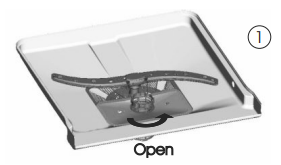
STEP 2: Lift the filter assembly up.
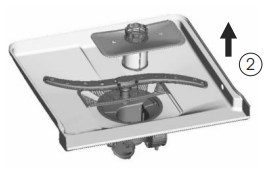
NOTES:
- When following this procedure from step 1 to step 2, the filter system will be removed; when following it from Step 2 to Step 1, the filter system will be installed.
- Inspect the filters for blocking after every time the dishwasher has been used.
- By unscrewing the coarse filter, you can remove the filter system. Remove any food remnants and clean the filters under running water.
- The entire filter assembly should be cleaned once a week.
Caring for the Dishwasher
- The control panel can be cleaned by using a lightly dampened cloth. After cleaning, make sure to dry it thoroughly.
- For the exterior, use a good appliance polish wax.
- Never use sharp objects, scouring pads or harsh cleaners on any part of the dishwasher.
Cleaning the Door
- To clean the edge around the door, you should use only a soft warm, damp cloth.
- To avoid penetration of water into the door lock and electrical components, do not use a spray cleaner of any kind.
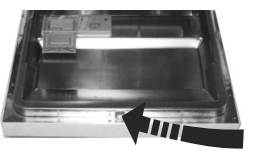
WARNING!
- Never use a spray cleaner to clean the door panel as it may damage the door lock and electrical components.
- Abrasive agents or some paper towels should not be used because of the risk of scratching or leaving spots on the stainless steel surface.
Protect against Freezing
Please take frost protection measures on the dishwasher in winter. After washing cycles, please operate as follows:
- Turn off the electrical power to the dishwasher.
- Turn off the water supply and disconnect the water inlet pipe from the water valve.
- Drain the water from the inlet pipe and water valve. (Use a pan to catch the water)
- Reconnect the water inlet pipe to the water valve.
- Remove the filter at the bottom of the tub and use a sponge to soak up water in the sump.
NOTE: If your dishwasher cannot work because of the ice, please contact an authorised service person.
Cleaning the Spray Arms
- It is necessary to clean the spray arms regularly for hard water chemicals will clog the spray arm jets and bearings.
- To remove the upper spray arm, hold the nut and rotate the arm clockwise to remove it.
- To remove the lower spray arm, pull out the spray arm upward.
- Wash the arms in soapy and warm water and use a soft brush to clean the jets. Replace them after rinsing them thoroughly

How to keep your Dishwasher in shape
- After every wash, turn off the water supply to the appliance and leave the door slightly open so that moisture and odours are not trapped inside.
- Before cleaning or performing maintenance, always remove the electrical plug from the socket.
- To clean the exterior and rubber parts of the dishwasher, do not use solvents or abrasive cleaning products. Only use a cloth with warm soapy water.
- To remove spots or stains from the surface of the interior, use a cloth dampened with water an a little vinegar, or a cleaning product made specifically for dishwashers
When not in Use for a long time
- It is recommend that you run a wash cycle with the dishwasher empty and then remove the plug from the socket, turn off the water supply and leave the door of the appliance slightly open. This will help the door seals to last longer and prevent odours from forming within the appliance
Moving the Appliance
- If the appliance must be moved, try to keep it in the vertical position. If absolutely necessary, it can be positioned on its back.
Seals
- One of the factors that cause odours to form in the dishwasher is food that remains trapped in the seals. Periodic cleaning with a damp sponge will prevent this from occurring
Cleaning the Filter
To clean the coarse filter and the fine filter, use a cleaning brush. Reassemble the filter parts as shown in the figures on the last page and reinsert the entire assembly in the dishwasher, positioning it in its seat and pressing downwards.
WARNING!
- When cleaning the filters, do not knock on them. Otherwise, the filters could be contorted and the performance of the dishwasher could be decreased.
Troubleshooting
Technical problems
| Problem | Possible Causes | Solution |
| Dishwasher doesn’t start | Fuse blown, or the circuit breaker acted | Replace fuse or reset circuit breaker. Remove any other appliances sharing the same circuit with the dishwasher |
| Power supply is not turned on |
Make sure the dishwasher is turned on and the door is closed securely. Make sure the power cord is properly plugged into the wall socket. |
|
| Error code:E1; Water pressure is low | Check that the water supply is connected properly and the water is turned on. | |
| Door of dishwasher not properly closed. | Make sure to close the door properly and latch it. | |
| Water not pumped from dishwasher | Kink in drain hose | Check drain hose. |
| Filter clogged | Check coarse the filter (see section titled " Cleaning The Filter ") | |
| Kitchen sink clogged | Check the kitchen sink to make sure it is draining well. If the problem is the kitchen sink not draining ,you may need a plumber rather than a serviceman for dishwashers. |
General problems
| Problem | Possible Causes | Solution |
| Suds in the tub | Improper detergent | Use only the special dishwasher detergent to avoid suds. If this occurs, open the dishwasher and let suds evaporate. Add 3.75 litres of cold water to the tub. Close and latch the dishwasher, then select any cycle. Dishwasher will drain out the water at the first step. Open the door after the draining has stopped and check suds have disappeared. Repeat if necessary. |
| Spilled rinse-aid | Always wipe up rinse-aid spills immediately. | |
| Stained tub interior | Detergent with colourant was used | Make sure that the detergent is the one without colourant. |
| White film on inside surface | Hard water minerals | To clean the interior, use a damp sponge with dishwasher detergent and wear rubber gloves. Never use any other cleaner than dishwasher detergent for the risk of foaming or suds. |
| There are rust stains on cutlery | The affected items are not corrosion resistant. | |
| A program was not run after dishwasher salt was added. Traces of salt have gotten into the wash cycle. | Always run the quick wash program without any crockery in the dishwasher and without selecting the Turbo function (if present), after adding dishwasher salt. | |
| The lid of the softer is loose | Check the lip .Ensure the fix is fine. |
Noise
| Problem | Possible Causes | Solution |
| Knocking noise in the wash cabinet | A spray arm is knocking against an item in a basket | Interrupt the program, and rearrange the items which are obstructing the spray arm. |
| Rattling noise in the wash cabinet | Items of crockery are loose in the wash cabinet | Interrupt the program, and rearrange the items of crockery. |
| Knocking noise in the water pipes | This may be caused by on-site installation or the cross-section of the piping. | This has no influence on the dishwasher function. if in doubt, contact a suitably qualified plumber. |
Unsatisfactory washing result
| Problem | Possible Causes | Solution |
| The dishes are not clean | The dishes were not loaded correctly. | See notes in " Loading the Dishwasher Baskets ". |
| The program was not powerful enough | Select a more intensive program. See" Wash Cycle Table ". | |
| Not enough detergent was dispensed | Use more detergent, or change your detergent. | |
| Items are blocking the path of spray arms. | Rearrange the items so that the spray can rotate freely. | |
| The filter combination in the base of wash cabinet is not clean or is not correctly fitted. This may cause the spray arm jets to get blocked. | Clean and/or fit the filter combination correctly. Clean the spray arm jets. See "Cleaning the Spray Arms". | |
| Cloudiness on glassware | Combination of soft water and too much detergent. | Use less detergent if you have soft water and select a shorter cycle to wash the glassware and to get them clean. |
| Black or gray marks on dishes | Aluminum utensils have rubbed against dishes. | Use a mild abrasive cleaner to eliminate those marks. |
| Detergent left in dispenser cups | Dishes block detergent cups. | Re-loading the dishes properly. |
Unsatisfactory drying result
| Problem | Possible Causes | Solution |
| The dishes are not drying | Improper loading | Load the dishwasher as suggested in the directions. |
| Too little rinse-aid | Increase the amount of rinse-aid/refill the rinse-aid dispenser | |
| Dishes are removed too soon | Do not empty your dishwasher immediately after washing. Open the door slightly so that the steam can escape. Begin unloading the dishwasher only once the dishes are barely warm to the touch. Empty the low basket first. This prevents water form dropping off dishes in the upper basket. | |
| Wrong program has been selected | In short program the washing temperature is lower. This also lowers cleaning performance. Choose a program with a long washing time | |
| Use of cutlery with a low-quality coating | Water drainage is more difficult with these items. Cutlery or dishes of this type are not suitable for washing in the dishwasher. |
ERROR CODES
When some malfunctions occur, the appliance will display error codes to warn you:
| Codes | Meanings | Possible Causes |
| E1 | Longer inlet time | Faucet is not opened, or water intake is restricted, or water pressure is too low |
| E4 | Overflow | Some element of dishwasher leaks |
| E8 | Failure of diverter valve. | Open circuit or break of diverter valve. |
WARNING!
- If overflow occurs, turn off the main water supply before calling service.
- If there is water in the base pan because of an overfill or small leak, the water should be removed before restarting the dishwasher.
See other models: DEAPF40WH DETHALASSA90B SW12BS DEDW645S CTZ2003BG
